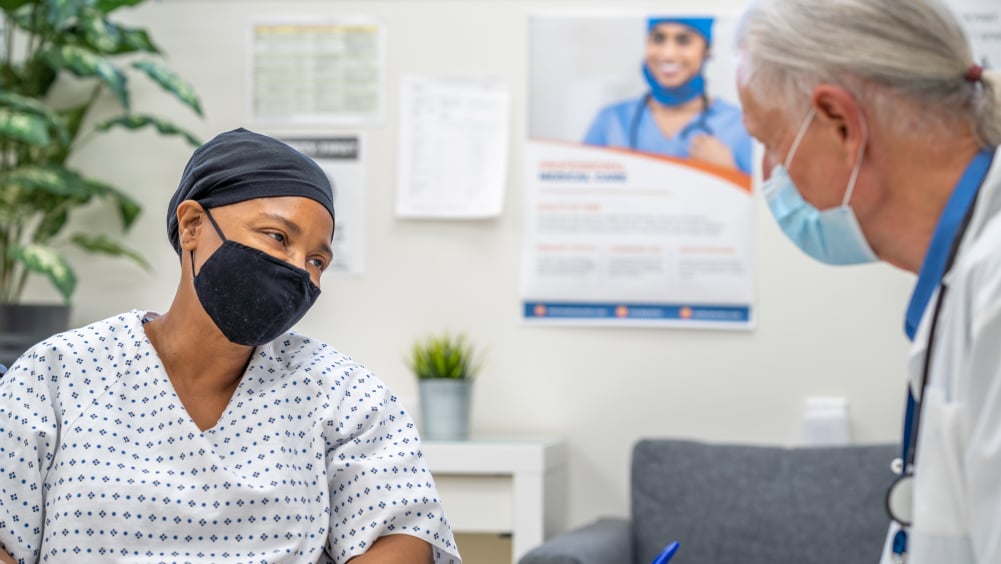Around the world, there are currently more than 90,000 clinical trials focused on cancer research. Each one is seeking to offer a new way of diagnosing, treating or preventing cancer and its symptoms.
If you or a loved one needs treatment for cancer, clinical trials are an option to consider. But you may be curious about clinical trials – how they are run, who is eligible to enroll, how they are overseen, and a number of other questions.
Amy Bodrog, MD, is an oncologist at the Lipson Cancer Institute and has experience treating patients who enroll in clinical trials. She explains how clinical trials are run for patients with cancer, how to find a trial, and what factors to consider before agreeing to enroll.
What are clinical trials?
Clinical trials for patients with cancer are research studies that provide patients with supplemental or new forms of treatment for all stages of cancer. These treatments are typically new drugs, procedures, or devices but can also test other aspects of care – such as ways to improve quality of life.
There are several different reasons why these treatments are being studied. Often, a novel treatment – or new treatment – may exist so that scientists can compare the new treatments to the current standards of care. Clinical trials also help show us which cancer treatments work and which do not, and provide additional options to people who otherwise may face limited choices by allowing access to potential treatments under investigation.
Each trial is unique and is part of a long, careful process that may take months or even years to arrive at a final result. If the results are successful, the treatment must be approved by the Food and Drug Administration (FDA) before it can be administered to patients who were not enrolled in the trial.
How to find a trial
Oncologists with Lipson Cancer Institute are consistently up to date with new and upcoming clinical trials for their patients. Asking your cancer care team about clinical trials is a good first step toward determining if a trial might be right for you.
The U.S. National Library of Medicine keeps a current searchable database of privately and publicly funded clinical trials. This is available at ClinicalTrials.gov.
Understandably, most people seeking out a clinical trial want to be treated as close to home as possible. Rochester is privileged to have several superb medical institutions in the area that offer clinical trials.
“Fortunately, in addition to our own clinical trials at Rochester Regional Health and the Lipson Cancer Institute, we also have an affiliation with Roswell Park Comprehensive Cancer Center in Buffalo and an excellent rapport with the University of Rochester Medical Center,” Dr. Bodrog said. “If there is a trial that we believe could be beneficial for one of our patients, we will refer them. Within the Northeastern U.S., Memorial Sloan Kettering Cancer Center and Dana Farber Cancer Institute are also relatively close and are considered outstanding institutions for clinical cancer trials.”
In addition to location, several other factors are taken into consideration when deciding if a patient can enroll in a trial. These include:
- Age group
- Type of cancer
- Past treatments received
- Current health status
Phases of enrollment
New treatments must pass through several “phases” before they can be released to the general public.
Before any testing of a drug can be conducted on people, it goes through lab studies or pre-clinical research. If researchers find promising results in cell or animal studies, the drug can move forward with more research. To conduct any trials using human subjects, the FDA must review and approve the investigational new drug application.
Once a clinical trial starts to enroll human patients, it will go through four phases. If the treatment is successful in one phase, it will move on to the next. Patients typically participate in only one phase of a trial.
Phase 1
This stage is considered experimental in most cases. Patients who join Phase 1 clinical trials have usually exhausted all other treatment options and want to try a novel therapy.
Clinical trials in this phase have a small number of participants enrolled – usually fewer than 50. The primary goal of a Phase 1 trial is determining if the treatment is safe and, if so, what dosage should be administered. Patients are closely watched for any adverse side effects.
“Part of the reason for Phase 1 trials is the potential benefit of the patient and the potential benefit of other patients in the future,” Dr. Bodrog said. “The main purpose of Phase 1 trials is to assess safety, so they may carry more risk to the individual enrolling.”
Phase 2
Conducting a clinical trial at this stage further scrutinizes the safety of a treatment, but also determines the effectiveness of the treatment in a specific patient population (such as those with a similar type of cancer). This phase of a trial can last up to two years.
A slightly larger pool of patients (between 50 and 100) is enrolled in these trials. These patients are given the dosage deemed to be safe and effective based on the results of the Phase 1 trial.
Patients are observed to determine any potential side effects and also look at the quality of life benefits offered by the treatment.
In some cases, drugs or therapies that are shown to be effective in Phase 2 trials can be submitted for FDA approval.
Phase 3
Hundreds or even thousands of people take part in a Phase 3 clinical trial. These trials seek to prove the effectiveness and safety of a new drug or therapy as compared to standard treatment. Participants are randomly assigned to receive either the new treatment or standard therapy.
In Phase 3 trials, doctors typically look to see whether the new treatment:
- gives patients a longer life
- provides a better quality of life
- results in fewer side effects
- shows fewer cases of cancer returning than standard treatment
At the end of Phase 3, when a new drug is shown to be more effective and safer than the current standard treatment, researchers can submit a new drug application, along with the results from the clinical trials, to the FDA for approval. Based on their review, the new treatment may become the new standard of care.
Phase 4
Once a drug or treatment is approved and goes out to market, a Phase 4 trial can begin. This type of trial focuses on long-term safety and the effectiveness of the treatment, as well as gathering information about potential adverse effects in a real-world environment.
This phase of trial has larger numbers compared to Phase 3 – often several thousand subjects.
Safety
Guidelines are put in place as part of a clinical trial protocol to outline the safety measures that will be taken for patients enrolled in the trial. These guidelines must then be reviewed and approved by an institutional review board - a committee of experts that makes sure a clinical trial is designed correctly, safely, and fairly.
“Anything that happens while a patient is on a clinical trial is reviewed to determine if the effect was related to the therapy,” Dr. Bodrog said. “Each phase of a trial has vigorous safety standards and adverse event reporting as a standard of care.”
The patient’s doctor and a clinical investigator will discuss what will happen during the clinical trial. This process – called informed consent – will cover:
- Purpose of the study
- Testing and imaging
- Use of a patient’s time
- Potential risks and benefits
- Potential safety concerns
“Throughout the clinical trial process, you are comparing something new with the current standard of care,” Dr. Bodrog said. “Oncologists are here to inform you about the best options for treatment – whether that is a current treatment or a clinical trial treatment. No matter what you ultimately choose, we will put your health and wellbeing first.”
Financial costs
The costs associated with clinical trials vary, depending on a number of factors. Most trials seek funding through private or public grants. However, if a trial is evaluating an existing treatment in a new and unique way, either a patient’s insurance or the institution or entity funding the trial will cover most costs for the patient.
Depending on the level of coverage offered during a trial, some costs for patients to consider include:
- Travel and transportation (if multiple out-of-town visits are involved)
- Accommodations (if multiple out-of-town visits are involved)
- Imaging and lab tests
- Doctor visits and hospital stays
The financial counselors at Lipson Cancer Institute can work with you and your insurance provider for any questions related to coverage for a clinical cancer trial.
The decision to continue a clinical trial always remains with the patient. It is their choice to continue with or leave a study at any time.
“Helping our patients to make an informed decision about their treatment is one of the most important responsibilities we have,” Dr. Bodrog said.









